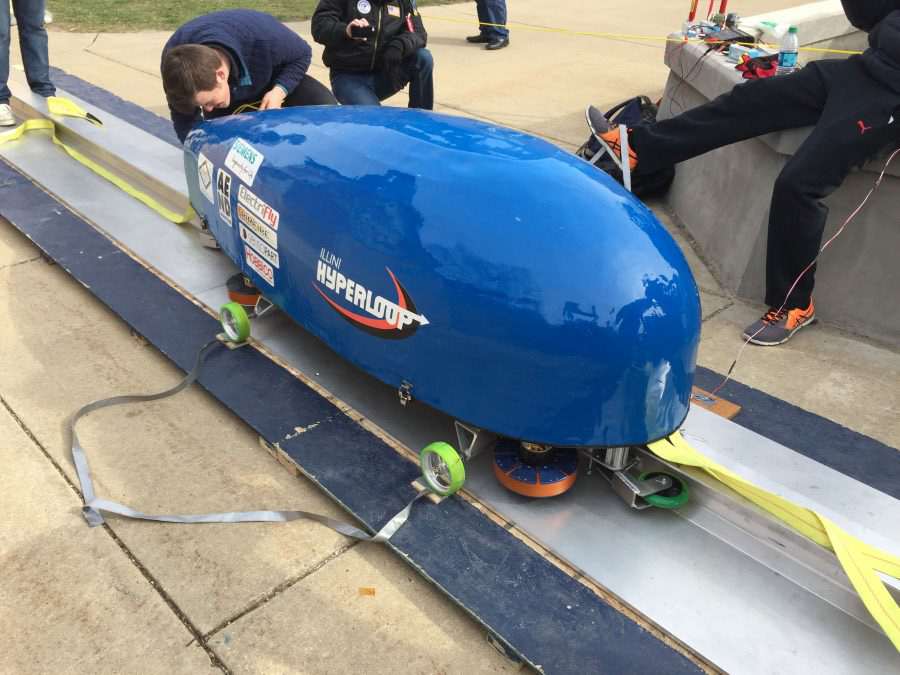Research department assists University students in innovative projects
Photo Courtesy of Mizan Rahman
Illini Hyperloop members examine the original pod they created for SpaceX’s hyperloop competition. The team will be competing in Competition II this August.
May 8, 2017
By Kevin Delgado
Staff Writer
The University research department provides opportunities for students to get involved in the innovation of various technological advancements.
The research department produced 380 technology disclosures, 103 patents and licensed 13 startups in 2016.
The Office of the Vice Chancellor for Research had research and development expenditures of $620 million last year, according to Melanie Loots, executive associate vice chancellor for research.
Get The Daily Illini in your inbox!
“While the primary mission of the office is focused on research, the Office of the Vice Chancellor for Research also play an important role in education, providing research opportunities for all students, continuing education and technical training, and training in the safe and ethical conduct of research,” Loots said. As the semester comes to an end, the University’s top research stories highlight the importance of the unit.
Lunar Lander
Alex Darragh and Matthew Steinlauf, freshmen in Engineering, designed a small lunar greenhouse equipped with seeds, water and fertilizer.
The device was designed to allow for plant growth on the moon.
TeamIndus, a private aerospace research organization in India, created a state of the art vehicle designed to travel through space and land on the moon’s surface near the lunar equator.
Darragh and Steinlauf’s team, Regolith Revolution, was one of eight teams and the only one from the U.S., who participated in the the Lab2Moon Challenge and was offered a spot on the Lunar Lander.
The Lab2Moon challenge allows youth from all over the world to design and construct a project that will innovate the ability to create sustainable life on the moon. Before Regolith Revolution could finalize their spot on the LunarLander, they were required to obtain a private sponsor to cover a $750,000 fee.
“Unfortunately, we were unable to find a sponsor for the project and the deadline to find one has passed,” Darragh said.
“Matt and I have loved this competition and are actively searching for more competitions like it.”
Illini Hyperloop
A group of University students created a human-sized pod that could potentially revolutionize the way people travel.
The design could decrease the average three-hour trip from Champaign to Chicago to 15 minutes upon completion.
The group entered their first pod in the SpaceX Hyperloop Pod Competition on Jan. 27. This pod is contained in a depressurized tube and only functions on battery power and magnetics.
The private organization is focused on the manufacturing and launching of advanced spacecrafts and created the competition to encourage the innovation of transportation technology.
After this competition, students were invited to Competition II in August 2017.
As opposed to Competition I, where winners were chosen based on factors such as pressurization inside the tube and cargo capacity, the second competition focuses on achieving maximum speed.
Due to the new set of requirements, the team designed a new pod that no longer uses active levitation, the ability to levitate at zero velocity. Instead, the group will use passive levitation, meaning the pod will need to be pushed until it reaches enough velocity to levitate on its own.
“During the construction of the pod, the team will use, build and design manuals that Illini Hyperloop and the University’s senior design team has collaboratively created,” said Rishab Pohane, Illini Hyperloop president and sophomore in LAS.
According to Pohane, after the construction of the pod is complete, it is expected to reach a speed of 250 mph.
NASA grants $750,000 to research park based start-up company
NASA granted a $750,000 grant to Serionix, a Research Park based startup company.
The grant was made possible by Small Business Innovation Research, where government agencies provide funding for projects they are interested in. The project began with NASA’s interest in removing ammonia from the air in spacesuits, providing astronauts with cleaner air.
Serionix received the grant to assist with their development of the technology that could prove beneficial in the removal of ammonia.
According to their website, the group’s work with the NASA Small Business Innovation Research program began in June 2016 and ended with the launch of air purifier filters and custom HVAC filters.
Serionix’s new focus is to develop a model that can be used to advance NASA’s spacesuit life support system.







